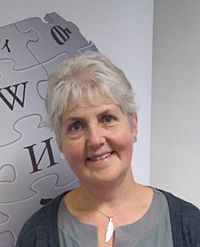Angharad Tomos facts for kids
Angharad Tomos, born on July 19, 1958, is a famous Welsh author. She is also known for being a strong supporter of the Welsh language. She has won the Tir na n-Og Award for her books.
Quick facts for kids
Angharad Tomos
|
|
|---|---|

Angharad Tomos
|
|
| Born | 19 July 1958 Bangor, Gwynedd, Wales |
| Occupation | Author and language activist |
| Language | Welsh |
| Education | Ysgol Gynradd Bontnewydd, Ysgol Dyffryn Nantlle, Aberystwyth University, Bangor University |
| Period | 1982– |
| Genre | Children's literature, adult fiction, non-fiction |
| Spouse | Ben Gregory |
Contents
About Angharad Tomos
Angharad Tomos grew up in Llanwnda, near Caernarfon, Wales. She was born in Bangor in 1958. She went to school in Bontnewydd and Dyffryn Nantlle. Later, she studied at Aberystwyth University. She also graduated from Bangor University. There, she studied Welsh and Sociology. She later earned a master's degree.
Angharad Tomos is married to Ben Gregory. They live in Pen-y-Groes, Gwynedd.
Her Books and Stories
Angharad Tomos has written many books for children in Welsh. She won an award at the Eisteddfod yr Urdd in 1982. This was for her book Hen Fyd Hurt, which means "Silly Old World." This book shared her thoughts about being unemployed. The main character, Heulwen, takes drawing lessons, just like Angharad did.
The Rwdlan Series
She wrote and drew pictures for the Rwdlan series. These are 13 books set in a place called Gwlad y Rwla. The first book, Rala Rwdins, came out in 1983. This series won the Tir na n-Óg prize. Some of her stories from this series were made into TV shows and plays. The Rwdlan books have also been translated into Irish and Breton.
Other Novels
In 1985, Angharad Tomos won a prize for her novel Yma o Hyd. This book is about her experiences when she was campaigning for the Welsh language. She had tried to climb a TV transmitter to show her concern. Yma O Hyd means "Still Here." It is written like a secret diary. The title comes from a popular Welsh song.
Her third novel, Si Hei Lwli, was published in 1991. The title comes from a Welsh lullaby. This book also has parts of her own life in it. It tells the story of a car journey. A young woman in her twenties travels with her aunt, who is in her nineties.
Titrwm, published in 1994, tells the story of a woman named Awen. She has trouble hearing and learning. But she learns to read and loves books. The only person she can talk to is her son, Titrwm. The title Titrwm sounds like a stone falling.
In 2004, she wrote Wele'n Gwawrio. This title comes from a Christmas carol. The book is about the start of a new millennium. The main character thinks about politics and finds comfort in religious thoughts.
She also wrote a historical novel called Rhagom in 2004. This book talks about the difficult times of the First and Second World Wars.
Her Writing Style
Angharad Tomos often includes parts of her own life in her books. She also uses humor and discusses big ideas. She often refers to Welsh stories, heroes, songs, and poems. Her books describe everyday life in a unique way. She uses local Welsh words and ways of speaking. This makes her writing feel very Welsh and real.
Her books often show a world where everyone doesn't have the same chances. She believes in making human rights better for everyone. Her ideas go beyond just Wales and look at the whole world.
She has also written travel stories and TV scripts. She has written plays, like Cyffes (1994). She also writes newspaper columns and articles for journals. Her autobiography, Cnonyn Aflonydd, came out in 2001.
Angharad Tomos writes a Welsh column for the Daily Post newspaper. She also has a blog on their website. In 2009, a sculpture of her was shown at Parc Glynllifon. This was part of a project about important women.
Supporting the Welsh Language
Angharad Tomos was the leader of a group called Cymdeithas yr Iaith. This group works to support the Welsh language. She was the chairwoman from 1982 to 1984. During this time, they started campaigns for a Welsh Language Act. They also worked to create a group to help Welsh language education.
Awards and Recognition
- 1982 – Crown, Eisteddfod yr Urdd for Hen Fyd Hurt
- 1986 – Tir na n-Og Award for Y Llipryn Llwyd (Cyfres Rwdlan)
- 1991 – Prose Medal, Welsh National Eisteddfod for Si Hei Lwli
- 1994 – Tir na n-Og Award for Sothach a Sglyfath (Cyfres Cled)
- 1997 – Prose Medal, Welsh National Eisteddfod for Wele'n Gwawrio
- 2009 – Mary Vaughan Jones Award

